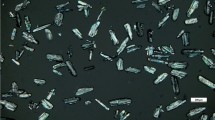Summary
The systemic disposition of theophylline after taking a new, sustained release tablet (Theolair Retard® 250 mg, Theolair S. R.®, Riker Laboratories) has been studied in 8 hospitalized patients. Absolute bioavailability was determined from the ratios of the areas under the serum concentration-time curves after intake of the tablet and after intravenous infusion of aminophylline in the same patient. The absolute bioavailability of Theolair Retard® 250 mg was 110.9±20.8% (mean ± SD). Maximal serum concentrations were reached after 7.3±3.5 h, the large intersubject variation being due to differences in gastric emptying time. The tablets appear to release theophylline slowly in acid conditions, but more rapidly in an alkaline medium. Invasion was found to be either monophasic with a rate constant of about 0.8 h−1 (intestine), or biphasic with rate constants of 0.2 h−1 (stomach) and 0.8 h−1 (intestine). The peak levels accounted for 7.9±2.2 mg · 1−1. The profiles of the serum concentration-time curves were such that the concentrations remained above 80% of cmax for 6.5±3.3 h. The relevant pharmacokinetic parameters (half-life of elimination, total body clearance and volume of distribution) were determined and were used to calculate the individual dosage regimens required to obtain therapeutic serum concentrations. The optimal dosing interval to obtain an average steady state serum concentration of 12.5 mg · l−1 was 9.8±3.1 h.
Similar content being viewed by others
References
Bogentoft C, Sjögren J (1980) Controlled release from dosage forms. In: Breimer DD (ed) Towards better safety of drugs and pharmaceutical products. Elsevier/North-Holland, Amsterdam, pp 229–246
Cabana BE (1980) Bioequivalence and “in vitro” testing of drug formulations. In: Breimer DD (ed) Towards better safety of drugs and pharmaceutical products. Elsevier/North-Holland, Amsterdam, pp 301–322
Domson JF, Hein EW, Sheen A, Sly RM (1979) Comparison of Theolair S.R.® and Theo-Dur® tablets. Ann Allergy 43: 220–222
Hein EW, Domson JF, Sheen A, Buffone GJ, Sly RM (1979) Simultaneous use of rapidly absorbed and sustained release theophylline preparations in children. Ann Allergy 43: 217–219
Hendeles L, Weinberger M, Johnson G (1978) Monitoring serum theophylline levels. Clin Pharmacokinet 3: 294–312
Jones DT, Sears MR (1980) Serum theophylline levels in adult asthmatics: comparison of oral sustained-release and micro-crystalline preparations. N Zealand Med J 92: 196–198
Jonkman JHG, Schoenmaker R, Greving JE, Zeeuw RA de (1980a) Rapid and selective theophylline serum and saliva assay by means of high pressure liquid chromatography. Pharm. Weekblad (Sci Ed) 2: 49–53
Jonkman JHG, Berg WChr, Schoenmaker R, Zeeuw RA de, Greving JE, Orie NGM (1980b) Disposition and clinical pharmacokinetics of microcrystalline theophylline. Eur J Clin Pharmacol 17: 379–384
Jonkman JHG, Schoenmaker R, Grimberg N, Zeeuw RA de (1981) A new in vitro dissolution test for controlled-release theophylline tablets. Int J Pharmaceutics 8: 153–156
Mitchell EA, Liang AYL (1980) Pharmacokinetics of Nuelin-SR 250 mg in asthmatic children: A new sustained-release theophylline. N Zealand Med J 92: 91–93
Ogilvie RI (1978) Clinical pharmacokinetics of Theophylline, Clin Pharmacokinet 3: 267–293
Ritschel WA (1980) Handbook of basic pharmacokinetics 2nd Ed, Drug Intelligence, Hamilton, ILL
Russel CJ, Elwood RK, Kinney C, McDevitt DG (1979) Comparison of plasma theophylline concentrations achieved with a microcrystalline formulation and a sustained release preparation of theophylline. Br J Clin Pharmacol 7: 425 P
Sheiner LB, Tozer TN (1978) “Clinical pharmacokinetics”: the use of plasma concentrations of drugs. In: Melmon KL, Morelli HF (eds) Clinical pharmacology. MacMillan, New York
Svedmyr N, Mellstrand T, Svedmyr K (1979) Clinical trial of a new, slow-release theophylline preparation (“Nuelin”-SR). Curr Med Res Opin 6 (Suppl 6): 40–45
Weinberger M, Hendeles L (1979) Formulations and dosage requirements for theophylline in the treatment of asthma. Curr Med Res Opin 6 (Suppl: 6): 116–132
Author information
Authors and Affiliations
Rights and permissions
About this article
Cite this article
Jonkman, J.H.G., Berg, W., de Vries, K. et al. Disposition and clinical pharmacokinetics of theophylline after administration of a new sustained release tablet. Eur J Clin Pharmacol 21, 39–44 (1981). https://doi.org/10.1007/BF00609586
Received:
Accepted:
Issue Date:
DOI: https://doi.org/10.1007/BF00609586




